
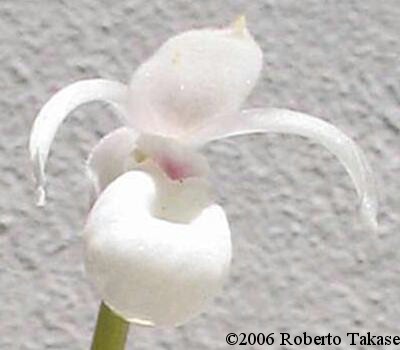
Mexipedium xerophyticum (Soto, Salazar & Hagsater) Albert & Chase
- Described: Soto, Salazar & Hagsater in Orquidea 12: 1-10 (1990)
- Creation of the new genus Mexipedium: Albert & Chase in Lindleyana 7(3): 172-176 (1992)
- Etymology: Named for the relatively dry habitat in which it lives (xerophyte, n. - a plant which survives in a dry habitat).
- History: Mex. xerophyticum was discovered in September, 1985 by Herbito Hernandez in Oaxaca, Mexico. "It was among material collected by a group of collaborators of Dr. Thomas Wendt of the College of Graduate Studies of Chapingo." (Ledoux 1996) In September, 1988 Hernandez, Eric Hagsater, Gerardo Salazar and Miguel Soto returned to the site and found seven plants. Small divisions were collected for study and the species was described as Phragmipedium Xerophyticum in December, 1990. Some of the plants were exported to Phrag. experts around the world, including Lucille McCook in the U.S.A., who received two clones. These two clones were later named 'Oaxaca' and 'Windy Hill', and are the source of every Mex. xerophyticum in cultivation in the U.S.A. (and possibly the world). The first known blooming in cultivation was by Lucille McCook, who exhibited the plant for AOS judging on June 27, 1992 as Phrag. xerophyticum. It was presented at the Mid-America Regional Supplemental Monthly Judging in Glencoe, Illinois, where it received a Certificate of Botanical Recognition. In the 1992
volume of Lindleyana, Albert & Chase erected the genus Mexipedium, segregating it from Phragmipedium on the basis of xerophyticum having a unilocular rather than trilocular ovary.
- Varieties & Forms: none
- Synonyms: none
- Chromosome Count -
| 2n = |
metacentrics |
telocentrics |
n.f. |
| 20 |
6 |
26 |
46 |
Plant Habit
- Leaves: 5-8, 12-18 cm long, 1-3 cm wide
- Inflorescence: up to 10 flowers per branch,, 1-4 branches, total length 10-30 cm
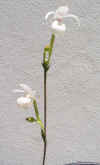
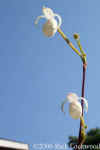
- Bloom: 2-2.5 cm wide, last up to 2 weeks







- Plant: new growths form on elongated rhizomes, roots emerge from the bases of the new growths, but not along the rhizomes
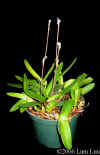



Habitat Data
- Distribution - known from a single site in Oaxaca, Mexico which is inaccessible during the rainy season
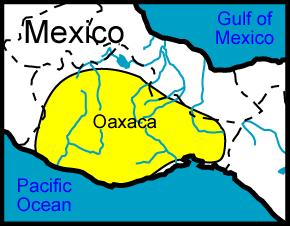
- Elevation: ~320 m
- Peak Flowering in the Wild: September (?)
- Ecology: small cracks in karst limestone outcrops in evergreen tropical rainforest
- Mean Temperature Range: 22-26° C
- Light: light-shade to partial sun
- Medium: calcareous, rooted in humus or on exposed rock
- Water: distinctly seasonal, wetter summers, dryer winters
Cultural Advice from Ledoux (1996)
- Light: 2,000-4,000 footcandles
- Temperature: summer days 28-29° C, nights 20-21° C; winter days 24-27° C, nights 16-18° C
- Humidity: 80-90% year-round
- Medium & Water: coarser mix than that used for Phrags
- Water: same schedule used for Phrags
- Fertilizer: 1/4 strength every 2 weeks
Notes
- Whether or not Mex. xerophyticum warrants its own genus is still a topic of some debate. I have chosen to use the genus Mexipedium based upon the cytological study of Cox et al. (1997) which showed a chromosome complement with an arm number (n.f. = 46) in between that of Phragmipedium (n.f. = 36-38) and Paphiopedilum (n.f. = 50-56).
- Although seeds have reportedly been obtained from hybridizing with phragmipediums, no hybrids have yet been registered and I have yet to see a photo of a purported hybrid bloom.
Sources:
- Albert, V. A., and M. W Chase. "Mexipedium: A New Genus of Slipper Orchid (Cypripedioideae: Orchidaceae)." Lindleyana 7, no. 3 (1992): 172-76.
- Aoyama, M., and K. Karasawa. "A Karyomorphological Study on Phragmipedium xerophyticum, Orchidaceae." Chromosome Science 1 (1997): 73-76.
- Cox, A.V., A.M. Pridgeon, and M.A.T. Johnson. "Cytological Characterization of Mexipedium xerophyticum (Cypripedioideae: Orchidaceae)." Lindleyana 12, no. 3 (Sep 1997): 162-65.
- Koopowitz, H. "Phragmipedium xerophyticum and Its Culture." Orchid Digest 59, no. 3 (Jul/Sep 1995): 108-10.
- Ledoux, M.M. "The Diminuitive Phragmipedium xerophyticum." Orchid Digest 60, no. 3 (Jul/Sep 1996): 122-28.
- McCook, L.M. "An Annotated Checklist of the Genus Phragmipedium." Orchid Digest 62, special publication (1998): 1-12.
Return to the Data Sheets Page
Page Created By: Stephen Manza
Last Updated: 2-18-07
contact: silence882@gmail.com
















